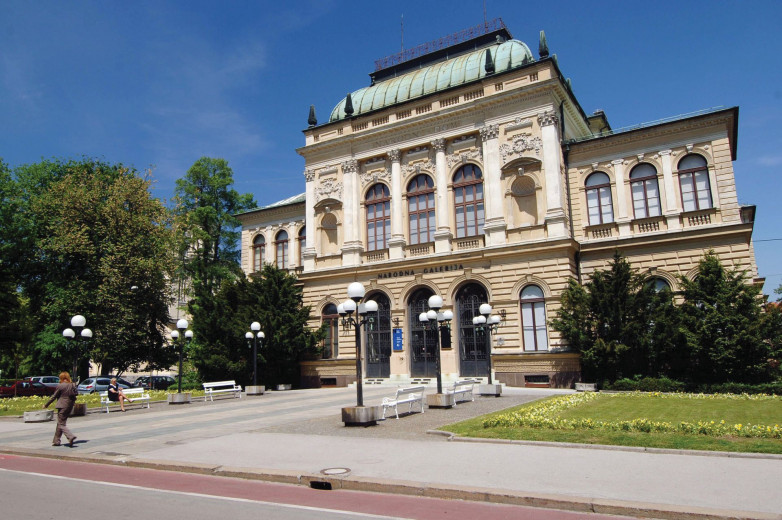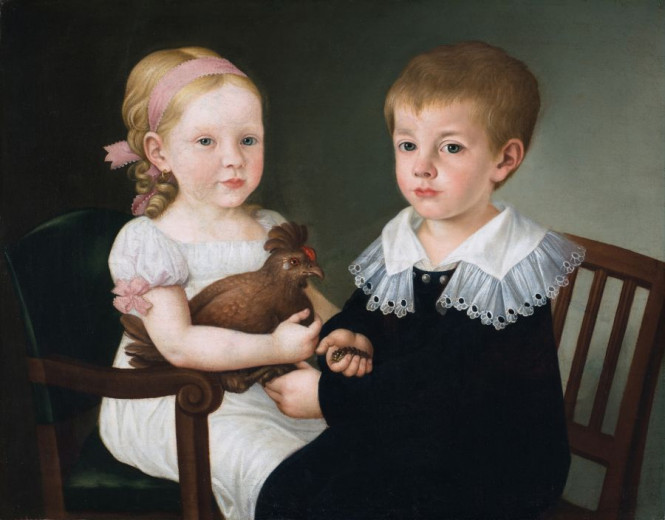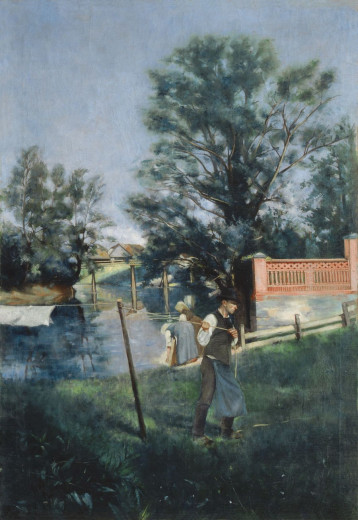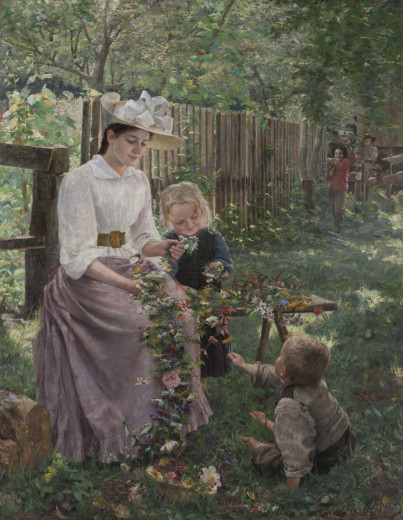Date: 13. January 2020
Time to read: 3 min
The National Gallery of Slovenia is the country’s principal institution dedicated to fine art from earlier periods, housing the largest art collection in the country, dating from the High Middle Ages to the 20th century.
The Narodna Galerija (National Gallery) society was founded in 1918. However, endeavours to create a home ("acropolis" as the gallery was named upon its establishment) for Slovenian art were already underway at the end of the 19th century. Among those advocating the establishment of a gallery were the polymath and journalist aristocrat Peter von Radics (1836–1912), the Mayor of Ljubljana, banker and diplomat Dr Ivan Hribar (1851–1941), and the Društvo za krščansko umetnost (Christian Art Society), which in 1907 compiled a collection of old Slovenian art. For decades Slovenians nourished the desire to have their own art institution, and this desire, yearning even, was finally fulfilled in 1925.
And thus from the dreams of the founders and supported by the high cultural awareness of Slovenians the National Gallery developed into one of the most prominent institutions of art and culture. In 1933 the Gallery held an opening ceremony for the expanded permanent exhibition of Slovenian fine art.
-
 The National Gallery Slovenia was originally housed in the Kresija Palace, where the first Permanent Exhibition was opened to the public in 1920. The Gallery relocated to the Narodni dom Palace in 1926, where it remains to this day. Photo: The National Gallery of Slovenia archives
The National Gallery Slovenia was originally housed in the Kresija Palace, where the first Permanent Exhibition was opened to the public in 1920. The Gallery relocated to the Narodni dom Palace in 1926, where it remains to this day. Photo: The National Gallery of Slovenia archives
-
 The National Gallery of Slovenia as it looks now. Photo: Domen Grögl
The National Gallery of Slovenia as it looks now. Photo: Domen Grögl
-
 The gallery´s programme counts approximately 4 major and 15 small-scale exhibitions per year. Photo: Daniel Novakovič/STA
The gallery´s programme counts approximately 4 major and 15 small-scale exhibitions per year. Photo: Daniel Novakovič/STA
Milestones
The beginnings are certainly the first milestone. They include the first monographic exhibitions of the painter Ivan Grohar and the Šubic brothers, which were followed by many others. A special milestone was the exhibition of Chinese painting in 1988. It was the National Gallery’s most visited exhibition up to that date. Standing out among the projects dedicated to Slovenian art is the great exhibition Gothic Art in Slovenia, which the National Gallery presented in 1995 in cooperation with the Faculty of Arts of the University of Ljubljana.
-
 The Robba Fountain, one of Ljubljana's best known Baroque monuments. Photo: Daniel Novakovič/STA
The Robba Fountain, one of Ljubljana's best known Baroque monuments. Photo: Daniel Novakovič/STA
-
 The story of the city’s symbol is tied to the set up of the original fountain in the middle wing of the National Gallery of Slovenia. Photo: Tamino Petelinšek/STA
The story of the city’s symbol is tied to the set up of the original fountain in the middle wing of the National Gallery of Slovenia. Photo: Tamino Petelinšek/STA
-
 The Robba Fountain in National Gallery of Slovenia. Photo: Tamino Petelinšek/STA
The Robba Fountain in National Gallery of Slovenia. Photo: Tamino Petelinšek/STA
Another milestone in the National Gallery's exhibition and research activities was an extensive exhibition of Slovenian impressionists and their contemporaries put on in 2008. It launched the exhibition of Slovenian Impressionists in the Parisian Petit Palais in 2013.
-
 The National Gallery's permanent collection, divided into sections according to historical periods, is comprised of nearly 600 works by Slovenian and European artists. Photo: Nationa Gallery of Slovenia archives
The National Gallery's permanent collection, divided into sections according to historical periods, is comprised of nearly 600 works by Slovenian and European artists. Photo: Nationa Gallery of Slovenia archives
-
 Grand staircase in the gallery. Photo: National Gallery of Slovenia archives
Grand staircase in the gallery. Photo: National Gallery of Slovenia archives
-
 Golden Hall. Photo: National Gallery of Slovenia archives
Golden Hall. Photo: National Gallery of Slovenia archives
-
 Great Hall, ceiling, detail. Photo: National Gallery of Slovenia archives
Great Hall, ceiling, detail. Photo: National Gallery of Slovenia archives
Permanent exhibitions
The National Gallery of Slovenia owns artworks from several artists in permanent collections, arranged by period from the High Middle Ages to the modern day. In addition to these collections classified by periods, the Gallery also owns the Zoran Mušič collection. The authors of artworks dating from the High Middle Ages to the Renaissance period (1200–1600) are mostly unknown, and the majority of works from this period are paintings, frescos and sculptures of a religious nature, mostly altarpieces.
-
 Crystal Reliquary of St John the Baptist's Blood by Anonymous, - (early 13th cent.), goldsmith's craft, 14 x 20 x 11.5 cm - Pleterje Charterhouse, Šentjernej / Provenance: Loan: Pleterje, Monastery of Carthusian monks. Photo: National Gallery of Slovenia archives
Crystal Reliquary of St John the Baptist's Blood by Anonymous, - (early 13th cent.), goldsmith's craft, 14 x 20 x 11.5 cm - Pleterje Charterhouse, Šentjernej / Provenance: Loan: Pleterje, Monastery of Carthusian monks. Photo: National Gallery of Slovenia archives
-
 Sinite Parvulos (Suffer the Little Children to Come Unto Me) oil, canvas, 145 x 188.5 cm by Otto van Veen, attributed (Leiden, 1556 – Brussels, 1629). Photo: National Gallery of Slovenia archives
Sinite Parvulos (Suffer the Little Children to Come Unto Me) oil, canvas, 145 x 188.5 cm by Otto van Veen, attributed (Leiden, 1556 – Brussels, 1629). Photo: National Gallery of Slovenia archives
-
 Empress Maria Theresa (after 1742), oil, canvas, 280 x 184.5 cm by Martin van Meytens the Younger (Stockholm, 1695 – Vienna, 1770). Photo: National Gallery of Slovenia archives
Empress Maria Theresa (after 1742), oil, canvas, 280 x 184.5 cm by Martin van Meytens the Younger (Stockholm, 1695 – Vienna, 1770). Photo: National Gallery of Slovenia archives
-
 The Judgement of Solomon (1817−1820), oil, canvas, 243 x 340 cm by Franc Kavčič/Caucig (Gorizia, 1755 – Vienna, 1828), National Gallery of Slovenia, Ljubljana. Photo: National Gallery of Slovenia archives
The Judgement of Solomon (1817−1820), oil, canvas, 243 x 340 cm by Franc Kavčič/Caucig (Gorizia, 1755 – Vienna, 1828), National Gallery of Slovenia, Ljubljana. Photo: National Gallery of Slovenia archives
-
 Julija Primic with Her Brother Janez (c. 1823), oil, canvas, 57.5 x 74 cm by Matevž Langus, attributed (Kamna Gorica, 1792 – Ljubljana, 1855), National Gallery of Slovenia, Ljubljana. Photo: National Gallery of Slovenia archives
Julija Primic with Her Brother Janez (c. 1823), oil, canvas, 57.5 x 74 cm by Matevž Langus, attributed (Kamna Gorica, 1792 – Ljubljana, 1855), National Gallery of Slovenia, Ljubljana. Photo: National Gallery of Slovenia archives
-
 Washerwomen by the Ljubljanica 1886, oil, canvas, 146 x 100 cm by Joseph Pewtkovich 1886. Photo: National Gallery of Slovenia archives
Washerwomen by the Ljubljanica 1886, oil, canvas, 146 x 100 cm by Joseph Pewtkovich 1886. Photo: National Gallery of Slovenia archives
-
 Woman Drinking Coffee, 1888, oil, canvas, 100 x 70 cm by: Ivana Kobilca. Photo: National Gallery of Slovenia archives
Woman Drinking Coffee, 1888, oil, canvas, 100 x 70 cm by: Ivana Kobilca. Photo: National Gallery of Slovenia archives
-
 Summer 1889–1890, oil, canvas, 180 x 140 cm by Ivana Kobilca. Photo: National Gallery of Slovenia archives
Summer 1889–1890, oil, canvas, 180 x 140 cm by Ivana Kobilca. Photo: National Gallery of Slovenia archives
-
 Before the Hunt, 1883, oil, canvas, 87 x 65.5 cm; National Gallery of Slovenia, Ljubljana by Jurij Šubic (Poljane nad Škofjo Loko, 1855 – Leipzig, 1890). Photo: National Gallery of Slovenia archives
Before the Hunt, 1883, oil, canvas, 87 x 65.5 cm; National Gallery of Slovenia, Ljubljana by Jurij Šubic (Poljane nad Škofjo Loko, 1855 – Leipzig, 1890). Photo: National Gallery of Slovenia archives
-
 The Larch, 1904, oil, canvas, 110 x 98 cm by Ivan Grohar (Sorica, 1867 − Ljubljana, 1911) ; National Gallery of Slovenia, Ljubljana. Photo:National Gallery of Slovenia archives
The Larch, 1904, oil, canvas, 110 x 98 cm by Ivan Grohar (Sorica, 1867 − Ljubljana, 1911) ; National Gallery of Slovenia, Ljubljana. Photo:National Gallery of Slovenia archives
-
 Sunny Hill, 1903, oil, canvas, 52 x 60 cm by Rihard Jakopič (Ljubljana, 1869–1943), National Gallery of Slovenia, Ljubljana. Photo: National Gallery of Slovenia archives
Sunny Hill, 1903, oil, canvas, 52 x 60 cm by Rihard Jakopič (Ljubljana, 1869–1943), National Gallery of Slovenia, Ljubljana. Photo: National Gallery of Slovenia archives
Knowledge is the foundation of respect for cultural heritage
Through play, conversation, and even organised birthday parties at the Gallery, children and adolescents can get to know the cultural riches of Slovenia and other nations. Members of Gal's Club discover and experience the exhibited artwork, which then become the inspiration for their own creations in the gallery workshop.
The Gallery also offers many educational programmes for adults: trips with the National Gallery abroad, seminars and lectures. It also organises family activities, e.g. designing amulets for year-round luck, making seals, painting in impressionist style, graphics workshops, sculpting, and so on.
The National Gallery can thus be a schoolroom for the general public, the host of various ideas and a place that encourages us to strive for the same goals as the Gallery's founders, who dreamt about a Slovenian "acropolis".
They dreamt that the Slovenian nation would have a treasury for spreading knowledge, change and experience. After a century we can say that their dreams have been realised, and will continue to be achieved in the future.






